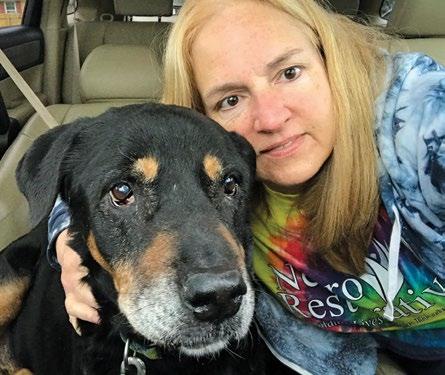
4 minute read
Passions: Pet Fostering
Pet Fostering: Why You Should Consider It
There are lots of reasons why mature adults are the perfect people to foster animals. With age comes wisdom, and you have learned what battles are worth fighting and which you aren’t likely to win. If you’ve raised children to adulthood you understand that fostering an animal isn’t going to be anywhere near that hard or time-consuming. If you have left the 40hour work week behind, you might also have more time to spend with animals.
Today’s Transitions talked to three Kentuckiana foster extraordinaires, Janet Meek, Kate Greer, and Connie Coin, who have found the experience to be tremendously rewarding and not nearly as overwhelming as one might expect.
EXTRA CARE FOR CANINES
In 2013, Janet adopted a three-legged dog, which opened her eyes to rescues, transports, and animals with special needs. Many organizations work to get animals from open admission shelters, some of which will euthanize animals that don’t get adopted or are ill. She began doing transports of animals to rescue organizations when she still lived in Tennessee.
Upon moving to Louisville in 2015, Janet, 68, began volunteering with a rescue organization and fostered four puppies. Eventually, she started her own nonprofit, Special Paws — A Small Dog Sanctuary, which provides a home to dogs that have special needs. “I really liked taking care of dogs that needed me. I’m an old social worker so I guess that’s where that comes from,” she says. Her house is now a sanctuary for dogs that might not otherwise get a forever home.
KITTENS AND KATE
Kate Greer and one of her foster kittens. Kate’s granddaughter, Shannon, who lives with her, suggested the two of them foster kittens. “She said, ‘Wouldn’t that be fun?’” Kate says with a laugh. They began in November 2020 and are now fostering their sixth group of kittens. Some fostering relationships have lasted several months while others have lasted only a couple of weeks. Taking care of animals was certainly something Kate, 83, already had experience with. “There’s not much I didn’t have growing up. We even had goats that my uncle sent my dad as a practical joke,” she says.

Kate Greer and one of her foster kittens.
This past summer they took care of a momma cat and her seven kittens which required a little more flexibility. Kate wasn’t able to use her office and started to take her laptop into another room for meetings. “With seven of them, when I was on a Zoom conference, it was a little hectic,” she says. Fostering keeps Kate young at heart.
ROTTWEILER LOVE
It was Connie’s adult daughter, Savannah, who got her into the MisPits and Friends fostering program. Savannah, who typically fosters puppies, showed her mom a picture of a senior Rottweiler who needed foster care. “I love Rottweilers, and I’ve had at least one Rottweiler in the house for the last 30 years,” Connie says. She decided to open her home to Ron.

Connie Coin and foster dog, Ron.
When she brought him home, he was sick. He had a urinary tract infection (UTI) and entropion, which is where the eyelids begin to fold inward and scratch the eyes. She honestly thought he might die the first week he was in her home, but she thought, “Even if that happens, at least he died in a nice warm place with someone that loved him.”
He had surgery to repair his eyelids (which Connie called “his facelift”), received medication for the UTI, and happily adjusted to foster life with Connie’s other two dogs. Because he was older, Connie, 59, was aware that she might be his retirement plan, and she was fine with that. He was quiet and laid-back. When a family wanted to adopt Ron, Connie knew she would miss him, but she also knew he was going to have his best life as the only dog in his new home where he would get all the attention.
FOSTERING BASICS
While each organization that works to foster animals may have their own guidelines or orientations, there are some similarities between them. First, foster parents are not responsible financially for the animals; food, medical care, and supplies are provided and/or covered by the organization.
Second, fosters aren’t just left to figure things out on their own; they receive training and support to ensure they are ok throughout the process. Kayla Garland, foster program manager at the Kentucky Humane Society, says they offer an online orientation and video for foster volunteers. “If they have any additional questions, we can discuss those things. Most of the time, I find that our fosters receive the largest amount of information during the first or second foster pickup. That’s when we really dive into the questions they have,” she says.
Foster volunteers may be given a general time frame of how long they will likely have the animal. Kayla says with puppies and kittens, it’s usually three to five weeks. “With adult animals, it really depends on why they need to go to foster,” she says. “We do have some cases that we expect [the animals] to be in foster [care] longterm, and we are upfront about that.”
One of the best things about volunteering as a foster is that it allows a person to set the schedule that matches their lifestyle. For example, a person who is planning a long trip can take a break from fostering for several months. Kayla says some fosters only do so one or two times a year.
By Carrie Vittitoe | Photos submitted










